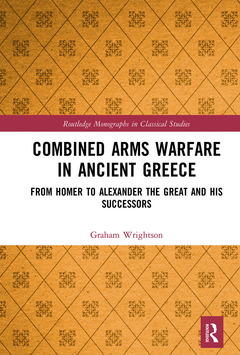Combined Arms Warfare in Ancient Greece From Homer to Alexander the Great and his Successors Routledge Monographs in Classical Studies Series
Auteur : Wrightson Graham

Combined Arms Warfare in Ancient Greece examines the timelines of military developments that led from the hoplite-based armies of the ancient Greeks to the hugely successful and multi-faceted armies of Philip II, Alexander the Great, and his Successors. It concentrates on the introduction and development of individual units and their tactical coordination and use in battle in what is termed "combined arms": the effective integration of different unit types into one cohesive battle plan and army allowing each unit to focus on its strengths without having to worry about its weaknesses.
This volume traces the development, and argues for the vital importance, of the use of combined arms in Greek warfare from the Archaic period onwards, especially concerning the Macedonian hegemony, through to its developmental completion in the form of fully "integrated warfare" at the battle of Ipsus in 301 BCE. It argues crucially that warfare should never be viewed in isolation in individual states, regions, conflicts or periods but taken as a collective whole tracing the mutual influence of other cultures and the successful innovations that always result.
Wrightson analyses Greek and Macedonian warfare through the lens of modern military theoretical terminology, making this study accessible to those with a general interest in military history as well as those studying this specific period.
List of figures; Acknowledgements; Introduction part 1: The purpose and methodology of the study; Introduction part 2: The theory of combined arms; Section 1: The Hoplite Revolution in Greece; Chapter 1: Homeric warfare and the introduction of the hoplite; Chapter 2: Archaic Greece – the dominance of the heavy infantry phalanx; Chapter 3: Persia vs. Greece - The advantages of the heavy infantryman; Section 2: The implementation of Combined arms in Greek warfare; Chapter 4: The Peloponnesian War - Combined arms innovation on the battlefield; Chapter 5: The Corinthian War and Iphicrates: Light infantry integration; Chapter 6: The Theban hegemony - the inclusion of heavy cavalry; Section 3: Macedon and Integrated Warfare; Chapter 7: Philip II – The sarissa phalanx and heavy cavalry; Chapter 8: Alexander the Great - linking the heavy cavalry and the phalanx; Chapter 9: The Successors - War elephants and integrated warfare; Conclusion - Greece, Persia and Macedon: The success of combined arms and integrated warfare; Bibliography; Index
Graham Wrightson is Assistant Professor of History at South Dakota State University, USA. His research focuses primarily on Macedonian military history with a special focus on military manuals and the sarissa phalanx. He also examines comparative warfare between cultures and eras and their influence on each other. He has published multiple articles and papers on Macedonian warfare, has jointly edited three books, and has produced a textbook for the standard US university first-year survey course Western Civilization 1.
Date de parution : 06-2021
15.6x23.4 cm
Date de parution : 03-2019
15.6x23.4 cm
Thèmes de Combined Arms Warfare in Ancient Greece :
Mots-clés :
Combined Arms; Young Man; Combined Arms Warfare; Alexander III; Heavy Infantry; Greek Warfare; Hoplite Phalanx; Integrated Warfare; Heavy Cavalry; Missile Troops; Combined Arms Army; Companion Cavalry; Light Infantry; Persian Cavalry; Hoplite Panoply; Greek Hoplites; Macedonian Army; Spartan Hoplites; Macedonian Phalanx; Van Wees; Sacred Band; Scythed Chariots; Syracusan Cavalry; Royal Hypaspists; Persian Infantry



